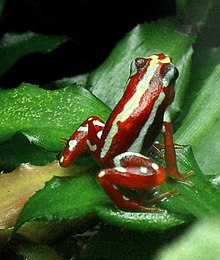Anthony's poison arrow frog
| Anthony's poison arrow frog | |
|---|---|

| |
| An individual in the Leipzig Botanical Garden, Germany | |
| Scientific classification | |
| Domain: | Eukaryota |
| Kingdom: | Animalia |
| Phylum: | Chordata |
| Class: | Amphibia |
| Order: | Anura |
| Family: | Dendrobatidae |
| Genus: | Epipedobates |
| Species: | E. anthonyi
|
| Binomial name | |
| Epipedobates anthonyi (Noble, 1921)
| |
| Synonyms[2] | |
|
Phyllobates anthonyi Noble, 1921 | |
Anthony's poison arrow frog (Epipedobates anthonyi) is a poison dart frog species in the family Dendrobatidae found in Ecuador and Peru.
Description
Anthony's poison arrow frog has a snout-to-vent length of about 19 to 26 mm (0.7 to 1.0 in). The hind legs are short and robust. The dorsal surface is usually dark red or brown and there are several yellowish-white oblique stripes and a central longitudinal stripe.[3]
Distribution and habitat
Anthony's poison arrow frog is known only from a number of locations in southwestern Ecuador and northwestern Peru at heights of between 153 and 1,769 m (502 and 5,804 ft) above sea level. Its natural habitat is the leaf litter on the floor of tropical dry forests, especially near streams.[1]
Biology
Anthony's poison arrow frog is diurnal and terrestrial. Males are territorial. A clutch of 15 to 40 eggs is laid on the ground among leaf litter and the male guards them till they hatch in about two weeks. He then carries them on his back to a suitable water body where the tadpoles develop to metamorphosis in about sixty days.[3]
Status
Anthony's poison arrow frog is listed as "Near Threatened" by the IUCN. Its population seems stable but it has a limited range, estimated to be less than 20,000 square kilometres (7,700 sq mi), and its habitat is being degraded by pollution from agrochemicals. It is also collected for medicinal use.[1]
References
- ^ a b c Coloma, Luis A.; Ron, Santiago; Lötters, Stefan; Venegas, Pablo (2010). "Epipedobates anthonyi". The IUCN Red List of Threatened Species. 2010. IUCN: e.T55213A11268789. doi:10.2305/IUCN.UK.2010-2.RLTS.T55213A11268789.en. Retrieved 3 January 2018.
- ^ Frost, Darrel R. (2017). "Epipedobates anthonyi (Noble, 1921)". Amphibian Species of the World: an Online Reference. Version 6.0. American Museum of Natural History. Retrieved 24 August 2017.
- ^ a b Maxon, Jeni (2008-12-09). "Epipedobates anthonyi". AmphibiaWeb. Retrieved 2013-12-21.

